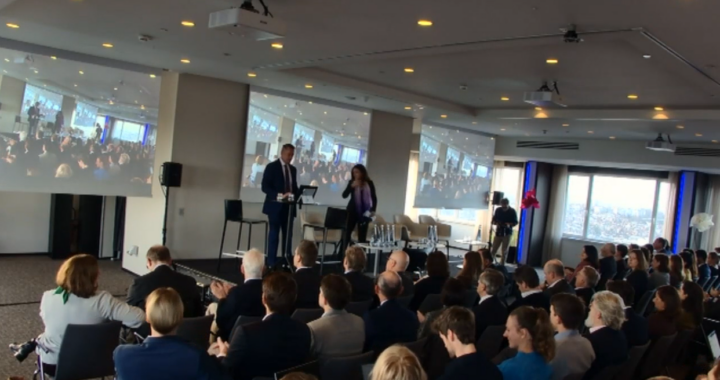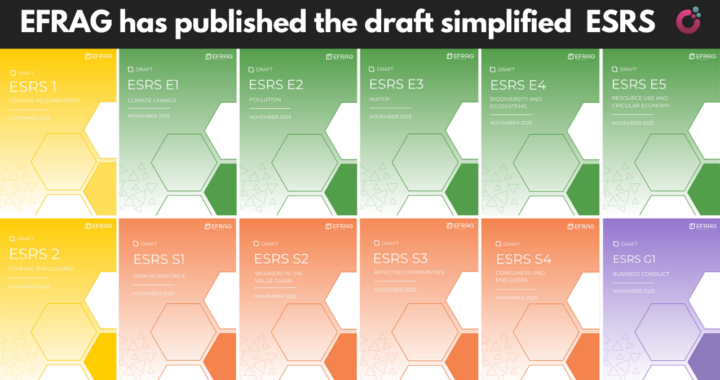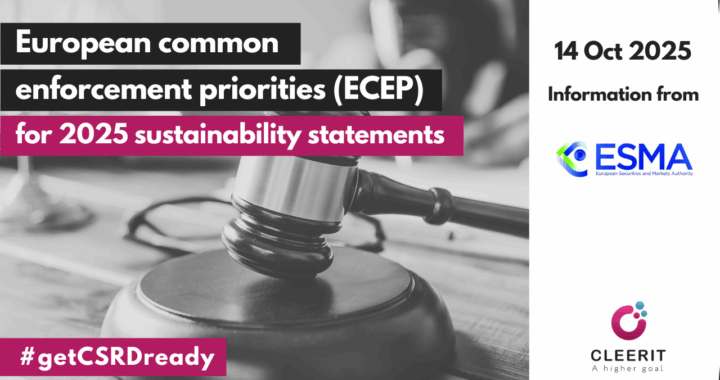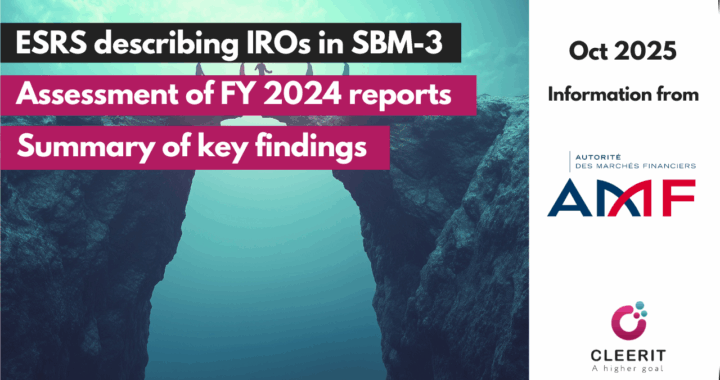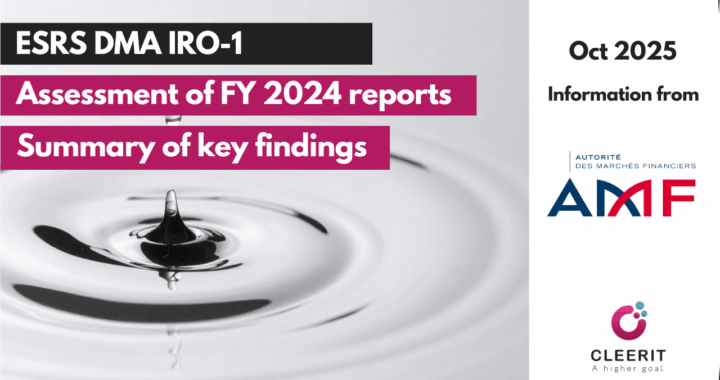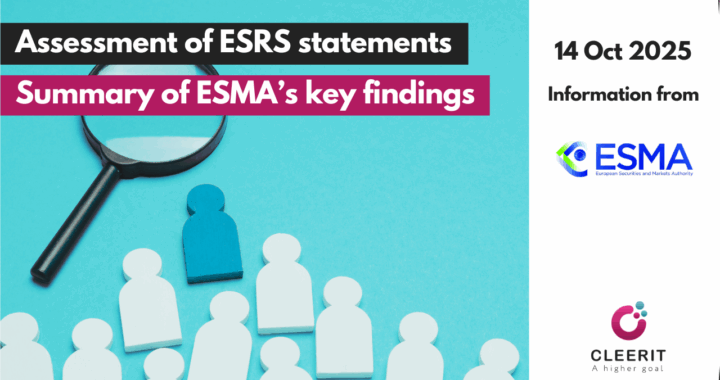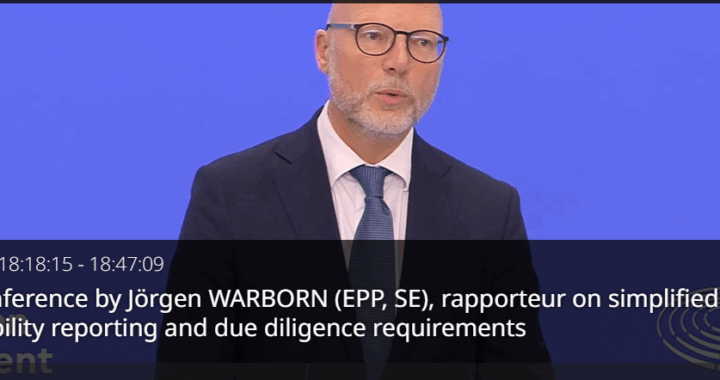As part of its objective to coordinate European supervision and enforcement related to corporate sustainability disclosures, ESMA has analysed 91 ESRS statements (whereof 31 voluntarily applied the ESRS) covering FY 2024, published by European issuers from 23 Member States listed in regulated markets, subject to limited assurance (or reasonable assurance in some cases) against ESRS.
The issuers were selected by national enforcers for the purpose of performing the analysis. Issuers with more than 1,000 employees represent 90% of the sample, while 78% have more than 3,000 employees. The median number of employees for the whole sample is close to 10,000 employees. The issuers of the sample are active in a broad variety of sectors.
ESMA’s conclusions are very valuable as it gives you information on what the financial marketplace is expecting from your sustainability reports.
Below you will a summary of the key findings related to disclosure of the double materiality assessment process (IRO-1), the disclosure of IROs (SBM-3) and auditor’s materiality considerations.
Based on these findings, ESMA urges issuers to:
- Avoid boilerplate disclosures in the description of their materiality assessment process and provide clarity on how they have exercised judgements.
- Whenever relevant, map their material IROs with the ESRS sustainability matters (ESRS 1 AR16) and use ESRS terminology to describe them.
- Identify the IROs for which entity-specific disclosures are provided in addition to ESRS disclosures.
- Disclose adopted Policies, Actions, Targets (or indicate their absence) and Metrics for each material sustainability matter, including the entity-specific matters (i.e. those that are not listed in AR16).
- More generally, ensure that the overall objective of the sustainability statement (i.e, disclose material IROs and describe how they are managed) is met and increase usability through facilitating connections between the disclosure of material IROs and the topical disclosures.
KEY FINDINGS
IRO-1 Double materiality assessment process
Around 60% of the sample met the overall objective of the IRO-1 disclosure requirement, which is to provide transparency on how the double materiality assessment was conducted. Although encouraging in the first year of application, this result shows room for improvement.
80% of the issuers reported that they used their sustainability due diligence to inform the materiality assessment process. Only 3 issuers disclosed that they had no due diligence process while 8% others did not report whether they had relied on their due diligence process although they conducted one.
While demonstrating that issuers have put in place formal steps to structure their materiality assessment, some disclosures were boilerplate and did not provide meaningful insight on the judgements made regarding the materiality of their Impacts, Risks and Opportunities (IROs), in particular for impacts.
The proportion of issuers disclosing sufficient information as required under the IRO-1 topical datapoints was lower, especially when the topic was eventually not found material (54%). In addition, less than 45% of the issuers disclosed these datapoints in the General information part of the sustainability statement.
A majority of the issuers in the sample provided a separate description of the processes for identifying, assessing, prioritising and monitoring impacts, and risks and opportunities. For 22% of the sample, however, it was not the case.
While risks and opportunities derive from impacts in many cases, a description of the process for determining the materiality of the associated financial risks can provide useful insights to the user of the sustainability statement, for instance regarding how the approach that was followed relates to the overall corporate risk assessment process.
For 72% of the issuers, it was clear that the materiality assessment process considered gross impacts. For the others, the situation was either unclear, or in some cases, materiality was assessed based on net impacts (integrating mitigation or prevention measures and controls to adjust the final score of impacts and/or risks). This unclarity or divergence in practice may hinder comparability of the materiality assessment results, for instance when considering two issuers from the same sector.
Regarding the use of thresholds in the materiality assessment process, either in relation to impacts or risks and opportunities, or both, close to 80% of the sample provided some explanations on how they had set qualitative or quantitative thresholds for determining their material IROs.
This result illustrates the effort made in structuring the materiality assessment process. Two issuers provided information only on impacts thresholds, and 17 (almost 20% of the sample) did not disclose any information about thresholds.
Good practices were especially noted regarding disclosure of thresholds for financial materiality, where some issuers provided detailed information on the nature of the threshold (e.g., based on revenue or EBITDA), with some also disclosing the quantitative threshold they have set.
As an example of good practice for impact materiality when relying on a 5-level scale (e.g., no impact, low, medium, high, very high), explanations were provided that, for the scope component of severity for an environmental impact, “low” corresponds to an issue observed in one location only and “medium” in a few locations, while “high” is widespread and “very high” observed in all locations.
This shows the attention issuers have paid to formalising the materiality assessment process.
However, some of them merely replicated in their disclosures the scoring steps suggested in the Implementation Guidance [EFRAG IG1]. This led to boilerplate disclosures in some cases (especially for impact materiality), when the issuers did not explain which considerations specific to their entity have been factored into the assessment.
Good practices for information on input parameters include the mention of specific tools or methodologies (e.g., LEAP approach for environmental matters, tools for the identification of areas at high water stress) or information sources (e.g., sector benchmarks, human rights country databases).
The other issuers did not disclose sufficient information on at least one of the three broad areas provided as examples in the standard (data sources, scope or assumptions). The least reported was the assumptions. Data sources or scope were also not reported in several cases.
A slight majority of issuers in the sample (54%) provided sufficient information on the IRO-1 datapoints of the topics eventually found non-material and more than 27% of the issuers did not provide any information.
SBM-3 Description of IROs and entity-specific information
Most issuers in the sample (close to 90%) provided a brief description of their material IROs DP ESRS2 SBM-3 par 48 (a).
For the remaining 10 issuers, the disclosures were found to be incomplete, either because the description was missing for one or more material IROs or because it was unclear.
In particular, the description of where, in the issuer’s business model, own operations or value chain, the IRO was concentrated was missing in a limited number of cases or considered insufficient.
Many of the IROs disclosed by issuers could be mapped to the ESRS sustainability matters (as listed in Application Requirement AR16 of ESRS 1), providing clarity and comparability for the users when those were covered by standardised topical disclosures.
In some cases, however, it was unclear from the description whether the IRO was related to an AR16 sub-topic or sub-sub-topic or not.
Close to 70% of the issuers disclosed entity-specific information, either related to IROs not covered by ESRS sustainability matters or complementing the ESRS disclosure requirements.
This could demonstrate a good understanding of the requirement to complement the ESRS disclosures with entity-specific disclosures when necessary, noting however that entity-specific disclosures are not to be used where ESRS disclosures would apply.
While some issuers opted to present their material IROs with a mapping of the AR16 (ESRS 1) sustainability matters they were related to, this is not an explicit requirement of the ESRS and the use of different terminology made the reconciliation difficult for some issuers, especially when the requirement to identify IROs covered by entity-specific disclosures was not complied with. This in turn made it difficult in some cases to ascertain that the embedded logic of the ESRS had been followed.
This logic calls for identification of the IRO and disclosure of Policies, Actions, Targets and Metrics for the related sustainability matter (or their absence) either through disclosing under the ESRS disclosure requirements or through providing entity specific disclosures. On this point, explicit signposting of the IROs covered by entity-specific disclosures as part of the SBM-3 disclosures, and of the entity-specific disclosures themselves, was noted as a good practice by national enforcers.
Notwithstanding the limitations noted above, the national enforcers sought to reconcile the IROs with the AR16 sustainability matters at topic, sub-topic and sub-sub-topic level to evaluate the granularity of the materiality assessment.
For Climate change (E1) sustainability matters, which 100% of the sample considered material, 94% of the issuers had at least one IRO referring to one of the sub-topics. For Resource use and circular economy (E5), which 78% of the issuers found material, 70% identified at least one IRO at sub-topic level.
For Own workforce (S1), national enforcers found that close to 80% of the issuers had at least one IRO which could be traced back to an AR16 sub-sub-topic. This reflects the higher granularity of the S1 sustainability matters in AR16 but also shows how, where they were provided with a more granular framework, issuers used it for conducting their materiality assessment and disclosing the results.
Depending on the topics sufficient granularity may be helpful for both preparers and users to more specifically identify the issue at stake and ensure relevant topical disclosures, either standardised or entity-specific where needed.
Regarding IROs covered by entity-specific disclosures, the largest group identified at topic level broadly relates to data, cybersecurity and use of AI. 26% of the sample disclosed an IRO related to these issues.
Some divergence in practices was noted by national enforcers as in some cases IROs which seemed similar were presented as a separate entity-specific matter, while in others they were associated with the Consumers and end users (S4) or Business conduct (G1) topics.
Guidance could be developed to help determine how these IROs can be connected with the ESRS framework and foster convergence in practice.
Other but less frequent entity-specific sustainability matters related to innovation and research, and tax.
For some of the IROs reported as material, it is questionable whether they refer to issues within scope of the sustainability statement (e.g., customers’ satisfaction, corporate citizenship).
In other cases, the limited description made it difficult to understand the related IRO (e.g., product portfolio, investment projects).
Targets
As part of the analysis, a check was conducted on whether targets had been disclosed for the sustainability matters found material, or in their absence, whether the issuer had provided a negative statement.
National enforcers found that more than 71% of the population disclosed either the targets or a negative statement. For the remainder, however, at least one target was missing with no negative statement.
This situation was more likely to be encountered in relation to social topics (especially Consumers and end users – S4) and Governance (G1) but was also noted for environmental topics for some of the issuers.
National enforcers noted that a number of targets were of a generic nature or expressed as high-level commitments.
Clear identification of the targets (as well as of policies and actions), or of their absence, in a summary table presenting them with the related material IROs and sustainability matters was noted as good practice, enabling easy reference for the user of the sustainability statement.
In a few cases, a clear indication of the non-materiality of the disclosure was missing, for instance when the issuer disclosed information on a sustainability matter which had not been considered material in the results of the materiality assessment.
Reporting of lists
Close to 90% of the sample provided a list of the disclosure requirements they had complied with. 85% reported a list of the datapoints derived from other EU legislation, with 70% reporting complete information, including whether these datapoints had been assessed to be material or not and where they could be found in the sustainability statement.
Assurance
The analysis also considered whether the auditor’s or assurance provider’s opinion referred to any materiality considerations.
For almost all issuers, the auditor or independent assurance services provider delivered unqualified limited assurance conclusions regarding the sustainability reports prepared in accordance with ESRS.
A qualified opinion was delivered for two issuers of the sample reporting under CSRD and ESRS.
The opinions pointed at significant omissions in the sustainability statement, including in relation to the materiality assessment for one of the issuers.
For four other issuers, the auditor or independent assurance services provider did not qualify its opinion but stressed materiality considerations as emphasis of matter in its opinion.
When related to the materiality assessment process, these were either of a general nature or more specific (highlighting for instance a disclosure mentioning the limitation of the materiality assessment in the supply chain to tier 1 for a specific sustainability matter).
In other cases, the emphasis of matter related to the application of the materiality regime prescribed by the ESRS (e.g., omission of material disclosures).
Emphasis of matters were also mentioned in relation to non-materiality-related reporting areas.
They pointed at, for instance, the scope limitations reported in the basis for preparation of the disclosures, the use of estimates or uncertainties associated with the quantitative metrics.
We strongly recommend that you use the IRO E/S/G plan in Cleerit to structure your information on IROs, policies, actions, targets and metrics related to sustainability matters in AR16 (pre-created in Cleerit), before including these the information in a tabular form into the datapoints in the ESRS templates. This will ensure that you structure the information as expected by the financial market. Don’t hesitate to contact us if you need further guidance on this point >>>
Source: https://www.esma.europa.eu/sites/default/files/2025-10/ESMA32-846262651-5288_Fact_finding_on_materiality_disclosures_in_sustainability_statements.pdf

